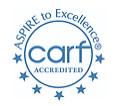The Townhall II Integrated Health Network Medical Clinic

What is Medication-Assisted Treatment?
Medication-assisted treatment (MAT) uses medication to reduce opioid cravings and decrease withdrawal symptoms. Combined with counseling and support, MAT is the most effective solution for opioid addiction.
We pledge to make your treatment safe, comfortable and welcoming. We will work with you to develop a treatment strategy that protects your health and your privacy, as we work toward a healthy outcome where you can manage your cravings and improve your quality of life.
When a patient visits the MAT clinic regularly, they receive a consistent dose of an opioid agonist, which stabilizes the patient so they do not require additional street opioids. The Medical Clinic works with the patient to calculate an ideal dosing level that takes away their cravings while helping them function in their daily lives.
To schedule an appointment call (330) 678-3006 or find out more about our Medical Clinics – including our hours of operation.
What is Medication for Opioid Use Disorder (MOUD)?
MOUD is replacing the term MAT, for Medication-Assisted Treatment. MOUD means Medication for Opioid Use Disorder. The terms MOUD and MAT are often used interchangeably, but the treatment community is moving toward MOUD as a better way to describe medication-assisted treatment. MOUD references a specific, medical treatment plan for opioid use disorder, while MAT covers a more comprehensive treatment plan that may include psychotherapy and counseling.
Learn more about the difference between MAT and MOUD.
What is the Science Behind Using Medication to Treat Opioid Use Disorder?
Opioids can be naturally-derived or synthetic, but they all have pain-killing effects on the brain. When prescribed, opioids can be beneficial for treating the pain of surgery or catastrophic injuries. Unfortunately, when opioids are abused, the brain physically changes to seek more and more opioids.
Opioids, once injested, travel to the brain and attach to the opioid receptors, generating feelings of numbness and euphoria. The mesolimbic system, which moderates the feeling of reward generated by dopamine, is the main system affected by opioids. Opioids stimulate the mesolimbic system to release large amounts of dopamine, which creates feelings of pleasure, while sedating the body’s activity. An opioid overdose occurs when the sedative effects overwhelm the body’s ability to breathe and maintain a proper heartbeat.
MOUD employs opioid agonists to occupy the opioid receptors and counter the opioid effects. Opioids induce intense effects but only stay in the brain for a short amount of time, which is why addicts crave more, but opioid agonists persist in the brain for a long time, while inducing only mild effects which can prevent the opioid user from feeling the effects of natural or synthetic opioids.
When an opioid agonist attaches, opioid receptors are occupied, mitigating the effects of opioid withdrawal which helps prevent relapse. The two most common opioid agonists are Methadone and Naloxone, the active medication in Narcan. Partial-agonist Buprenorphine is combined with naloxone to create the medication known as Suboxone.
What are the Stages of Medication-Assisted Treatment?
In the Induction Phase, you receive your first dose of Suboxone at the Medical Clinic. Our doctors and nurses will prescribe an appropriate dosage, however that may be adjusted over time until an effective dose is realized.
In the Stabilization Phase, you receive daily treatment, resulting in fewer cravings and less withdrawal symptoms. As you develop a stable recovery, you’ll engage with counselors and support services to discover the causes of your opioid use and to modify future behavior.
In the Maintenance Phase, you’ll receive a therapeutic dosage of medication that allows you to live a healthier, more hopeful lifestyle.
What is Methadone?
While Townhall II’s Medical Clinic does not currently offer Methadone, it is important to note it’s history in the treatment of opiate addiction.
Methadone was the first opioid agonist approved for medication-assisted treatment (MAT) in the United States. Introduced as an analgesic in the U.S. in 1947, methadone has been used in medication-assisted treatment since 1964. Methadone is an opioid agonist that binds to the same receptors in the brain as oxycodone, heroin and fentanyl.
Treatment with methadone minimizes the effects of withdrawal for approximately 24 hours. While methadone blocks the opioid receptors, using illicit opioids, such as street heroin or fentanyl, will not produce a “high.” Methadone produces less side effects than illicit opioids, so it’s safer and can be used regularly in treatment.
Therapeutic dosing is contingent upon individual patient needs. The amount of oral methadone a patient requires is dependent on the amount and power of the opioids they consumed prior to initiating treatment.
With the emergence of other medications for the treatment of opioid addiction such as Suboxone, Methadone therapy is no longer the dominant medically-assisted addiction treatment.
What is Buprenorphine/Suboxone?
Buprenorphine was approved by the United States Food and Drug Administration (FDA) in 2002. Buprenorphine and Suboxone (Buprenorphine with Naloxone) are used to treat people with opioid addiction. The effects of Buprenorphine last longer than Methadone, which means opioid users need fewer doses per week.
Buprenorphine does not have as many withdrawal symptoms as Methadone, has lower risk for overdose and has lower potential for abuse. Therefore, it is more effective for unsupervised treatment than Methadone.
Side Effects of Suboxone Treatment
Most side effects of Buprenorphine or Suboxone are mild, however it is critical to let your MOUD provider know if you experience any symptoms so they can change your dose. Reported side effects include: Headaches, mood swings, sleep issues, upset stomach or vomiting, constipation, cold or flu-like symptoms and sweating.
During intake, our doctor will ask you about other medications you are taking and provide you with a list of safety precautions. Using cocaine or amphetamines during medication-assisted treatment interferes with your outcome and can have deadly consequences.
Are the Medications Used in Treatment Addictive?
Buprenorphine, or Suboxone, targets the same areas of the brain as other opioids, but when they are used as prescribed, there is significantly less risk for misuse, abuse and addiction.
Can I Receive MAT or MOUD if I am Pregnant?
The health of your baby is as important to us as your successful treatment outcome. In most cases, prescribed dosages of Suboxone are safe to use if you are pregnant or breastfeeding, however it’s important that we coordinate your treatment with your health service providers to ensure the health and safety of your child.
Can Medication for Opioid Use Disorder Interfere with My Other Prescriptions?
It’s important that you let your MOUD provider, and your counselor, know about all medications you are currently taking to ensure that your treatment is safe and effective.
Does Insurance Cover Addiction Treatment?
Insurance coverage typically covers addiction treatment services. The Mental Health Parity and Addiction Equity Act require insurers to cover addiction treatment. Treatments covered include medication-assisted treatment, counseling, in-patient rehab, partial hospitalization and more.
To assess your treatment needs and verify your insurance coverage call us at 330-678-3006.
Will Medicaid or Medicare Cover My Treatment?
In most cases, Medicaid and Medicare will cover the cost of counseling, medication-assisted treatment, rehab and more.
If you don’t have insurance, contact us at 330-678-3006 and we can provide you with options to cover the cost of your care.
Learn more about MAT, MOUD and the changes in terminology for Opioid Use Disorder and Treatment.






